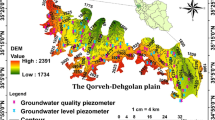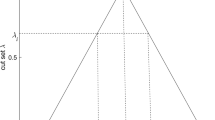Abstract
Oil spills on the ground cause significant damage to the geological environment, including groundwater, contaminating it and making it uninhabitable. Therefore, it is necessary to predict the scale of the oil spill and the consequences of contamination of the geological environment to minimize the damage. In the literature, there are plenty of approaches for oil spill prediction on the water. However, there is a lack of approaches for predicting oil spills in the geological environment. This paper proposes a new fuzzy model for predicting oil spills on the ground. It uses fuzzy set theory to express the uncertainty of the spilled oil volume and the specific oil capacity to make predictions more efficient and effective. It consists of the following parts: formulating a hypothesis based on initial oil spill data, fuzzy modelling of oil spill penetration, evaluating the hypothesis of whether the spilled oil will penetrate the ground layer and groundwater and finally evaluating the effectiveness of the proposition. The accuracy and reliability of the proposed model were assessed using synthetic data of oil spill penetrations into the ground and predictions of nine experts. The obtained experimental results show that the proposed fuzzy model is valid and does not contradict reality. Furthermore, statistical parameter (MAE and RMSE) shows that the proposed fuzzy model can predict the geological oil spill consequences with sufficient accuracy. It is practical and contributes to the body of knowledge in predicting geological oil spills. In addition, it will assist the practitioner in making decisions about how to respond to an oil spill.














Similar content being viewed by others
References
Statistical Review of World Energy. BP p.l.c., https://www.bp.com/content/dam/bp/business-sites/en/global/corporate/pdfs/energy-economics/statistical-review/bp-stats-review-2020-full-report.pdf (2020). Accessed 6 Jan 2021
Zhou, S., Wang, M., Yang, Z., Zhang, X.: Polydopamine-modified nanochannels in vertically aligned carbon nanotube arrays for controllable molecule transport. ACS Appl. Nano Mater. 2(5), 3271–3279 (2019)
Nyssanbayeva, G., Kudaibergenov, K., Seidildayeva, A.: Synthesis of modified nanocarbon materials and determination of their adsorption capacity. IJMPERD 10(1), 305–314 (2020)
Jiao, Z., Jia, G., Cai, Y.: A new approach to oil spill detection that combines deep learning with unmanned aerial vehicles. Comput. Ind. Eng. 135, 1300–1311 (2019)
Krohling, R.A., Campanharo, V.C.: Fuzzy TOPSIS for group decision making: a case study for accidents with oil spill in the sea. Expert Syst. Appl. 38(4), 4190–4197 (2011)
Hu, G., Mohammadiun, S., Gharahbagh, A.A., Li, J., Hewage, K., Sadiq, R.: Selection of oil spill response method in Arctic offshore waters: a fuzzy decision tree based framework. Mar. Pollut. Bull. 161 (2011)
Zhao, Q., Wang, J.: Disaster chain scenarios evolutionary analysis and simulation based on fuzzy petri net: a case study on marine oil spill disaster. IEEE Access 7, 183010–183023 (2019)
Feng, D., Passalacqua, P., Hodges, B.R.: Innovative approaches for geometric uncertainty quantification in an operational oil spill modeling system. J. Mar. Sci. Eng. 7(8), 259 (2019)
Yekeen, S.T., Balogun, A.L., Yusof, K.B.W.: A novel deep learning instance segmentation model for automated marine oil spill detection. ISPRS J. Photogramm. Remote. Sens. 167, 190–200 (2020)
Yekeen, S., Balogun, A.L.: Advances in remote sensing technology, machine learning and deep learning for marine oil spill detection. Prediction and vulnerability assessment. Remote Sen. 12(20), 3416 (2020)
Kim, G.D., Kim, Y.H.: A survey on oil spill and weather forecast using machine learning based on neural networks and statistical methods. J. Korea Converg. Soc. 8(10), 1–8 (2017)
Keramea, P., Spanoudaki, K., Zodiatis, G., Gikas, G., Sylaios, G.: Oil Spill modeling: a critical review on current trends, perspectives, and challenges. J. Mar. Sci. Eng. 9(2), 181 (2021)
Wu, Y., He, C., Liu, Y., Su, M.: A backscattering-suppression-based variational level-set method for segmentation of SAR oil slick images. IEEE J. Select. Topics Appl. Earth Observ. Remote Sens 10(12), 5485–5494 (2017)
Cherednichenko, O., Yanholenko, O., Vovk, M., Tkachenko, V.: Formal modeling of decision-making processes under transboundary emergency conditions. In: Data-centric business and applications, pp. 141–162. Springer, Cham (2020).
Mardani, A., Liao, H., Nilashi, M., Alrasheedi, M., Cavallaro, F.: A multi-stage method to predict carbon dioxide emissions using dimensionality reduction, clustering, and machine learning techniques. J. Clean. Prod. 275 (2020)
Liu, X., Wirtz, K.W.: Decision making of oil spill contingency options with fuzzy comprehensive evaluation. Water Resour. Manage 21(4), 663–676 (2007)
Lourenzutti, R., Krohling, R.A.: A generalized TOPSIS method for group decision making with heterogeneous information in a dynamic environment. Inf. Sci. 330, 1–18 (2016)
Ye, X., Chen, B., Lee, K., Storesund, R., Zhang, B.: An integrated offshore oil spill response decision making approach by human factor analysis and fuzzy preference evaluation. Environ. Pollut. 262 (2020)
Akyuz, E., Celik, E.: A quantitative risk analysis by using interval type-2 fuzzy FMEA approach: the case of oil spill. Marit. Policy Manag. 45(8), 979–994 (2018)
Davies, A.J., Hope, M.J.: Bayesian inference-based environmental decision support systems for oil spill response strategy selection. Mar. Pollut. Bull. 96(1–2), 87–102 (2015)
Zhuk, E., Khaliulin, A., Zodiatis, G.: On-line applications of numerical models in the Black Sea GIS. In: Proceedings of Fifth International Conference on Remote Sensing and Geoinformation of the Environment (RSCy’2017). SPIE, Cyprus (2017).
Lehikoinen, A., Luoma, E., Hanninen, M., Storgard, J., Kuikka, S.: Probabilistic risk assessment and decision support tools for the evaluation of oil transport in the Gulf of Finland, North-Eastern Baltic Sea. In: Proceedings of International Congress on Environmental Modelling and Software Managing Resources of a Limited Planet, Sixth Biennial Meeting. iEMSs, Leipzig (2012).
Shaban, M., Salim, R., Abu Khalifeh, H., Khelifi, A., Shalaby, A., El-Mashad, S., El-Baz, A.: A deep-learning framework for the detection of oil spills from SAR data. Sensors 21(7), 2351 (2021)
Cantorna, D., Dafonte, C., Iglesias, A., Arcay, B.: Oil spill segmentation in SAR images using convolutional neural networks. A comparative analysis with clustering and logistic regression algorithms. Appl. Soft Comput. 84 (2019)
Pashna, M., Yusof, R., Ismail, Z.H., Namerikawa, T., Yazdani, S.: Autonomous multi-robot tracking system for oil spills on sea surface based on hybrid fuzzy distribution and potential field approach. Ocean Eng. 207 (2020)
Krestenitis, M., Orfanidis, G., Ioannidis, K., Avgerinakis, K., Vrochidis, S., Kompatsiaris, I.: Oil spill identification from satellite images using deep neural networks. Remote Sens. 11(15), 1762 (2019)
Siciliano S.: Nature can heal itself after an oil spill, it just needs a little help. The conversation. https://theconversation.com/nature-can-heal-itself-after-an-oil-spill-it-just-needs-a-little-help-98054 (2020). Accessed 26 Jan 2021
Amir-Heidari, P., Raie, M.: Response planning for accidental oil spills in Persian Gulf: a decision support system (DSS) based on consequence modeling. Mar. Pollut. Bull. 140, 116–128 (2019)
Ye, X., Chen, B., Li, P., Jing, L., Zeng, G.: A simulation-based multi-agent particle swarm optimization approach for supporting dynamic decision making in marine oil spill responses. Ocean Coast. Manag. 172, 128–136 (2019)
Methodology for calculating the minimum equipment of emergency rescue services (formations) intended for localization and liquidation of oil and oil products spills on the territory of Russia, the Russian Federation of the Project, MC of Russia, MC of the Russian Federation, Moscow, Russia (In Russian). pp. 4–5, 39 (2012)
Goldberg, V.M., Gazda, S.: Hydrogeological foundations of groundwater protection from pollution. Hydrogeological basis for protest of groundwater from pollution (In Russian). Nedra (1984)
Bel’kova, S.V.: Determination of environmental restrictions in case of accidents on main oil pipelines. Determination of environmental damage in case of accidents on oil trunk pipelines (In Russian). OmGTU Publ., Omsk (2010)
Burmakova, A.V., Smelov, V.V., Zakharov, A.A.: Rehabilitation of the complex mathematical model of predicting the consequences of an emergency spill of oil products (in Russian). Trudy BGTU. Series Phys. Math. Inf. 2(206), 82–87 (2018)
Zadeh, L.A.: Fuzzy sets. Inf. Control 8(3), 338–353 (1965)
Klir, G., Yuan, B.: Fuzzy sets and fuzzy logic: theory and applications. Prentice Hall, New Jersey (1995)
Zimmermann, H.J.: Fuzzy set theory—and its applications. Springer Science & Business Media, New York (2011)
Borisov, A.N., Krumberg, O.A., Fedorov, I.P.: Decision-making based on fuzzy models. Zinatne, Riga (1990).. ((in Russian))
Zadeh, L.A.: The concept of a linguistic variable and its application to approximate reasoning. Information sciences. 8(3):199–249(I) (1975); 8(4):301–357(II) (1975); 9(1):43–80 (1975).
Kostikova, A.V., et al.: Expert fuzzy modeling of dynamic properties of complex systems. ARPN J. Eng. Appl. Sci. 11(17), 10601–10608 (2016)
Choi, B., Rhee, F.: Interval type-2 fuzzy memberships function generation methods for pattern recognition. Inf. Sci. 179(13), 2102–2122 (2009)
Pedrycz W.: Operations on Fuzzy Sets. An Introduction to Computing with Fuzzy Sets. Intelligent Systems Reference Library, pp. 79–93. Springer, Cham (2021)
Willmott, C., Matsuura, K.: Advantages of the Mean Absolute Error (MAE) over the Root Mean Square Error (RMSE) in assessing average model performance. Clim. Res. 30, 79–82 (2005)
Merriman, M.: A list of writings relating to the method of least squares, with historical and critical notes. Kessinger Publishing, LLC (2010)
Song, G., Wang, Z., Bai, L., Zhang, J., Chen, L.: Detection of oil wells based on faster R-CNN in optical satellite remote sensing images. In: Image and Signal Processing for Remote Sensing XXVI (Vol. 11533, p. 115330J). International Society for Optics and Photonics (2020)
Ozigis, M.S., Kaduk, J.D., Jarvis, C.H.: Mapping terrestrial oil spill impact using machine learning random forest and Landsat 8 OLI imagery: a case site within the Niger Delta region of Nigeria. Environ. Sci. Pollut. Res. 26(4), 3621–3635 (2019)
Ahmed, A.M., Duran, O., Zweiri, Y., Smith, M.: Quantification of hydrocarbon abundance in soils using deep learning with dropout and hyperspectral data. Remote Sens. 11(16), 1938 (2019)
Author information
Authors and Affiliations
Corresponding author
Rights and permissions
About this article
Cite this article
Kalibatiene, D., Burmakova, A. Fuzzy Model for Predicting Contamination of the Geological Environment During an Accidental Oil Spill. Int. J. Fuzzy Syst. 24, 425–439 (2022). https://doi.org/10.1007/s40815-021-01145-3
Received:
Revised:
Accepted:
Published:
Issue Date:
DOI: https://doi.org/10.1007/s40815-021-01145-3




